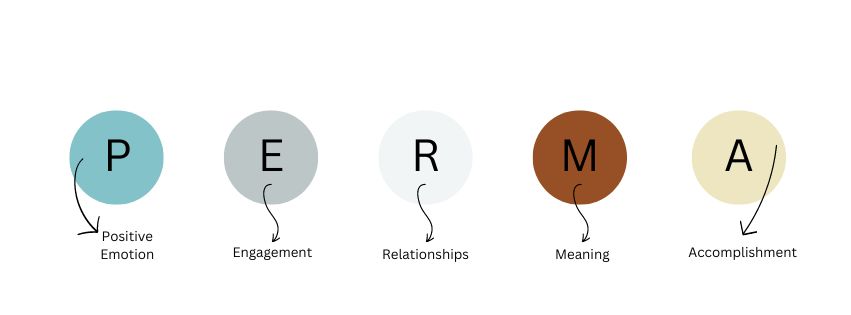The PERMA Model of Well-being: Building a Life of Fulfillment
In the world of positive psychology, few frameworks have had as much impact as the PERMA model of well-being. Developed by dr Martin Seligman, this model provides a comprehensive roadmap for improving well-being and leading a fulfilled life. In this blog post, we will explore Seligman’s PERMA theory, examine each component of the model, and offer practical advice on how to apply it in your daily life.
Introduction to the PERMA Model of Well-being
Before developing the PERMA model, Seligman introduced the Authentic Happiness theory, which primarily focused on happiness. However, he realized this approach lacked depth because happiness alone is too dependent on fluctuating moods and temporary emotions. Well-being, he argued, goes beyond mere happiness, encompassing a broader range of elements that contribute to a life of meaning and flourishing. This insight led to the creation of the PERMA well-being model, which consists of five elements: Positive Emotion, Engagement, Relationships, Meaning, and Accomplishment. Together, these elements provide a comprehensive approach to the psychology of well-being and offer actionable steps for improving well-being.

The PERMA Model of Well-being Explained
The PERMA well-being model is grounded in the idea that well-being is multi-dimensional. Seligman’s PERMA theory suggests that the five components—Positive Emotion, Engagement, Relationships, Meaning, and Accomplishment—are essential for a flourishing life. Each element stands on its own, contributing uniquely to overall well-being. Here is the PERMA model explained in more detail:
- Positive Emotion: This includes feelings of happiness, joy, and pleasure. Positive emotions help us enjoy life’s experiences and serve as a cornerstone for well-being.
- Engagement: Engagement refers to the concept of “flow,” or being fully absorbed in an activity. When we are engaged, we lose track of time and are completely immersed in the task at hand.
- Relationships: Positive relationships are crucial for well-being. Whether it’s with family, friends, or colleagues, our connections with others significantly impact our sense of fulfillment.
- Meaning: Finding meaning in life refers to having a sense of purpose, whether through work, family, or spirituality. A meaningful life often involves contributing to something greater than oneself.
- Accomplishment: Accomplishment refers to achieving goals and having a sense of mastery or success. This can be in any area of life, whether personal or professional.
Martin Seligman’s PERMA model revolutionized the field of positive psychology, offering a more inclusive and structured framework for understanding and enhancing well-being. According to many renowned researchers in positive psychology, the PERMA model stands as the most comprehensive and widely accepted model for well-being. Let’s delve into each element in greater detail, exploring how we can apply them in our daily lives to promote lasting fulfillment and happiness.
Positive Emotion: Cultivating Positivity
Positive emotion is the first and perhaps the most recognizable component of the PERMA model. It involves experiencing joy, pleasure, and happiness. However, Seligman emphasizes that this goes beyond just feeling good—positive emotions also provide resilience against life’s challenges.
Practical ways to improve well-being through positive emotion include:
- Gratitude practices: Keep a gratitude journal to reflect on positive aspects of your life.
- Savoring the moment: Take time to enjoy small joys, such as a beautiful sunset or a meaningful conversation.
- Spa and relaxation: Treat yourself to a spa day or a long bath to relieve stress and boost positive emotions.
- Sexual activity: Physical intimacy can release oxytocin and endorphins, contributing to emotional closeness and positive feelings.

Engagement: Finding Flow
The second pillar, Engagement, refers to becoming fully immersed in activities that challenge and excite you. When we experience “flow,” we lose track of time and self-consciousness, fully concentrating on the task at hand. Seligman believes that finding engagement in our daily activities is essential for long-term fulfillment.
To boost engagement:
- Use your strengths: Identify your signature strengths and find ways to use them in your work or hobbies.
- Challenge yourself: Seek out activities that require skill but are not too overwhelming. This balance will help you achieve a flow state.
- Playing sports or games: Engage in team sports or competitive games, which challenge you mentally and physically, promoting focus and immersion.
- Playing musical instruments: Learning or playing an instrument is a powerful way to boost engagement and well-being. It requires focus, coordination, and creativity, which can help you enter a state of flow.

Relationships: The Power of Connection
Positive relationships are essential for a flourishing life. Studies have shown that people with strong social connections are generally happier and more resilient. Building and maintaining these relationships can significantly improve our sense of well-being.
Ways to nurture relationships include:
- Regular check-ins with loved ones: Call or meet up with friends and family regularly.
- Active listening: Be fully present in your interactions, offering support and understanding.
- Gratitude visit: Express your appreciation in person to someone who has had a positive impact on your life, strengthening your bonds.
- Find friends at work: Building relationships at your workplace can lead to a more fulfilling work environment, which boosts overall well-being.

Meaning: Finding Purpose in Life
Finding meaning in life is about understanding your purpose and contributing to something bigger than yourself. Whether through work, volunteering, or spiritual practices, having a sense of purpose greatly enhances overall well-being.
To find meaning:
- Reflect on your values: Aligning your daily actions with what matters most to you can provide a deep sense of purpose.
- Spirituality: Engaging in spiritual practices, like prayer or meditation, can help foster meaning and a sense of connection to something larger.
- Finding meaning at work: Reflect on how your job positively contributes to the greater good, which can increase your sense of purpose and fulfillment.
- Volunteer work: Getting involved in community projects or charity work provides opportunities for making a meaningful difference in others’ lives.

Accomplishment: Striving for Success
The final pillar of the PERMA model is Accomplishment. Achieving goals and experiencing success provides a sense of pride and satisfaction. Seligman suggests that accomplishment, pursued for its own sake, is crucial for a well-rounded sense of well-being.
How to focus on accomplishment:
- Set achievable goals: Break larger tasks into smaller, actionable steps to avoid overwhelm and build a sense of accomplishment.
- Celebrate successes: Acknowledge both big and small wins to maintain motivation and boost self-esteem.
- Growth: Focus on personal development by learning new skills or taking up challenges that promote progress and achievement.
- Reflect on past achievements: Periodically remind yourself of your previous accomplishments, which can boost your confidence and sense of pride.

How to Apply the PERMA Model of Well-being Daily for Flourishing
Incorporating the PERMA model of well-being into your daily life doesn’t have to be overwhelming. Here are some practical ways on how to improve well-being with PERMA:
Positive Emotion
Start each morning with a few moments of mindfulness by focusing on positive emotions. For example, take 10 minutes to savor your morning coffee or tea without distractions. You can also try activities that naturally boost mood, like going for a short walk in nature or indulging in a relaxing spa evening with candles and soft music. Another way to enhance positive emotion is through touch; a simple hug or cuddle can release oxytocin, improving your mood. Also, be sure to start a gratitude journal and list three things you’re grateful for each day.
Engagement
Engage in hobbies that immerse you fully in the present moment. Try something creative like drawing, knitting, or playing a musical instrument. Playing sports or physical activities, such as tennis, rock climbing, or dance, can also engage both your mind and body, putting you in a flow state. Alternatively, find time to learn a new skill, even if it’s just dedicating 20 minutes a day to reading or an online course. You can also experience a state of flow by using your signature strengths.
Relationships
Nurture your relationships by planning quick social activities. Make time for meaningful conversations with loved ones, even if it’s just a quick phone call. Host a virtual coffee break with friends, set aside time for a gratitude visit where you thank someone important to you, or plan weekly family dinners. If your work environment allows, build connections by taking lunch breaks with colleagues or engaging in team-building activities. Small gestures like checking in via text or writing a heartfelt note can also strengthen bonds.
Meaning
Finding meaning doesn’t have to be overwhelming. Reflect on your core values and find ways to incorporate them into your daily routine. Spend time volunteering for a cause that matters to you or reflect on how your current job contributes to the greater good. Engage in spiritual practices, whether it’s through meditation, prayer, or spending time in nature. Consider starting a journaling habit where you write about the ways your daily actions align with your values.
Accomplishment
Set small, daily goals to experience a sense of progress and success. Keep a “done” list instead of just a “to-do” list. At the end of each day, write down what you’ve accomplished, no matter how small. This helps foster a sense of pride. Reflecting on past achievements can boost self-esteem and remind you of your capabilities. Set aside time to celebrate milestones, whether it’s completing a project at work or hitting a personal fitness goal.
By applying these strategies, you can improve your well-being and lead a more fulfilled life.

Conclusion: The PERMA Model of Well-being
The PERMA model in positive psychology provides a comprehensive framework for living a flourishing life. Seligman’s PERMA theory goes beyond the superficial aspects of happiness, offering a deeper understanding of well-being that includes positive emotion, engagement, relationships, meaning, and accomplishment. By focusing on these five pillars and incorporating them into our daily lives, we can cultivate lasting happiness and fulfillment. Remember, flourishing is a journey, not a destination, and it requires consistent effort and intentionality.
Quick Tip: For those looking to take their well-being to the next level, we offer coaching, positive psychotherapy, and programs for companies designed to boost employee well-being. To learn more about these services, visit https://4happyu.com.
Resources
The information in this article is grounded in scientific research. If you’re interested in specific studies, feel free to reach out to us.
For daily doses of joy, positivity, inspiration, and motivation, be sure to follow us on Instagram.
Za naše bralce v Sloveniji
Če vas zanima več o psihoterapiji in iskanju trajne sreče, preberite naslednje članke: Psihoterapija Obala, 5 ključev do trajne sreče in notranjega miru, Najboljši psihoterapevti v Sloveniji: Kako se hitro spopasti s stresom, Psiholog v Kopru: Kako odpraviti težave s psihoterapijo in RTT terapijo, in Psihoterapija Online: Prednosti in učinkovitost terapije na daljavo.


